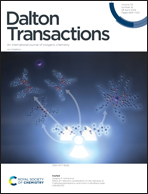Reactions of (mesityl)n(methyl)2−nsilylene complexes with pyridine-N-oxide (n = 1 and 0): formation of silanone complexes and a disiloxanyloxy complex†
Abstract
Silanones (O![[double bond, length as m-dash]](https://www.rsc.org/images/entities/char_e001.gif) SiR2), a heavier congener of ketones (R2C
SiR2), a heavier congener of ketones (R2C![[double bond, length as m-dash]](https://www.rsc.org/images/entities/char_e001.gif) O), are highly reactive species that are readily converted to oligomeric siloxane (O–SiR2)n. Coordination of silanones to the transition-metal fragments to afford silanone-coordinated complexes is a reliable silanone stabilization method. Recently, our group reported the synthesis, structures, and reactivity of dimesityl-substituted silanone complexes Cp*(OC)2M{O
O), are highly reactive species that are readily converted to oligomeric siloxane (O–SiR2)n. Coordination of silanones to the transition-metal fragments to afford silanone-coordinated complexes is a reliable silanone stabilization method. Recently, our group reported the synthesis, structures, and reactivity of dimesityl-substituted silanone complexes Cp*(OC)2M{O![[double bond, length as m-dash]](https://www.rsc.org/images/entities/char_e001.gif) SiMes2(L)}(SiMe3) (M = W, Mo, L: Lewis base, Cp*: η5-C5Me5, Mes: 2,4,6-Me3C6H2). Herein, to investigate the effect of substituents on the silicon atom during the formation of a silanone complex, we demonstrated the use of Mes and smaller Me groups. As a result, the formation of Mes(Me)-substituted silanone molybdenum complex Cp*(OC)2Mo{O
SiMes2(L)}(SiMe3) (M = W, Mo, L: Lewis base, Cp*: η5-C5Me5, Mes: 2,4,6-Me3C6H2). Herein, to investigate the effect of substituents on the silicon atom during the formation of a silanone complex, we demonstrated the use of Mes and smaller Me groups. As a result, the formation of Mes(Me)-substituted silanone molybdenum complex Cp*(OC)2Mo{O![[double bond, length as m-dash]](https://www.rsc.org/images/entities/char_e001.gif) SiMes(Me)(py)}(SiMe3) (5b, py: pyridine) was suggested, the silanone tungsten complex Cp*(OC)2W{O
SiMes(Me)(py)}(SiMe3) (5b, py: pyridine) was suggested, the silanone tungsten complex Cp*(OC)2W{O![[double bond, length as m-dash]](https://www.rsc.org/images/entities/char_e001.gif) SiMes(Me)(DMAP)}(SiMe3) (4a, DMAP: 4-(dimethylamino)pyridine) was obtained, and a dimethyl-substituted disiloxanyloxy(dioxo) complex Cp*(O)2W(OSiMe2OSiMe3) (9) was formed. The reaction of 4a with PMe3 proceeded via the elimination of DMAP and migration of the SiMe3 group to the oxygen atom of the silanone ligand to afford Cp*(OC)2W(SiMes(Me)OSiMe3)(PMe3) (11a). The Mo complex Cp*(OC)2Mo(SiMes(Me)OSiMe3)(PMe3) (11b) was produced by the reaction of Cp*(OC)2Mo{
SiMes(Me)(DMAP)}(SiMe3) (4a, DMAP: 4-(dimethylamino)pyridine) was obtained, and a dimethyl-substituted disiloxanyloxy(dioxo) complex Cp*(O)2W(OSiMe2OSiMe3) (9) was formed. The reaction of 4a with PMe3 proceeded via the elimination of DMAP and migration of the SiMe3 group to the oxygen atom of the silanone ligand to afford Cp*(OC)2W(SiMes(Me)OSiMe3)(PMe3) (11a). The Mo complex Cp*(OC)2Mo(SiMes(Me)OSiMe3)(PMe3) (11b) was produced by the reaction of Cp*(OC)2Mo{![[double bond, length as m-dash]](https://www.rsc.org/images/entities/char_e001.gif) SiMes(Me)}(SiMe3) (7b) with pyridine-N-oxide in the presence of PMe3.
SiMes(Me)}(SiMe3) (7b) with pyridine-N-oxide in the presence of PMe3.



 Please wait while we load your content...
Please wait while we load your content...